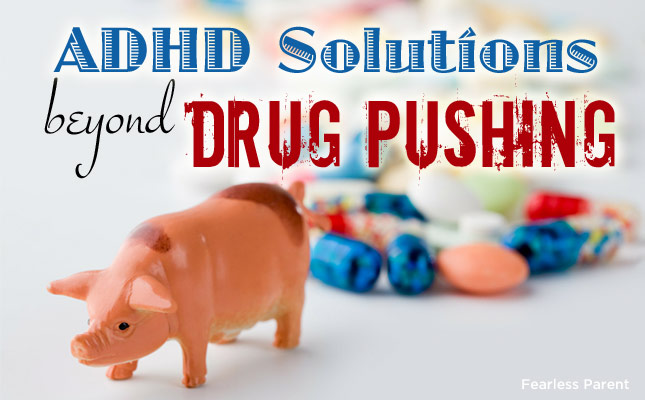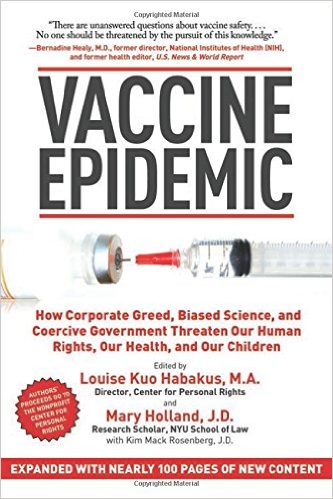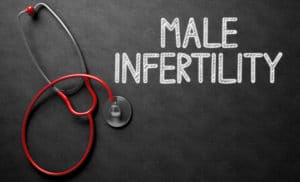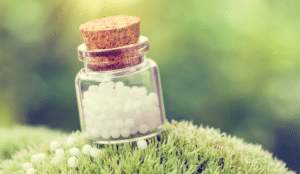“She has a remarkable ability to attend and stay on task,” said my daughter’s nursery school teachers as we sat together on diminutive, paint-splotched furniture. My mind wandered to greater, unstated questions: what is happening to children, how are we being manipulated by industry to interpret it, and how can awareness be raised around better ADHD solutions, looking beyond drug pushing on kids?
The making of an epidemic
The New York Times recently published an uncharacteristically candid and provocative article: Selling of Attention Deficit Disorder. It is in line with Robert Whitaker, author of Anatomy of an Epidemic and host of Mad in America, who strives to expose the profit-driven machine into which our children are fed. The article begins with a bird’s eye view of the alarming statistics:
- Centers for Disease Control and Prevention show that the diagnosis had been made in 15% of high school-age children, and that the number of children on medication for the disorder had soared to 3.5 million from 600,000 in 1990…
- Behind that growth has been drug company marketing that has stretched the image of classic A.D.H.D. to include relatively normal behavior like carelessness and impatience, and has often overstated the pills’ benefits.
Psychiatry is a voracious blob
Psychiatry seeks to consume our population. From 1994 to 2003, for instance, there was an8,000% increase in children 0-19 treated for Bipolar Disorder. Critics implicate:
- direct to consumer advertising (only legal in the US and New Zealand), including comics for kids,
- financial courtship of doctors who claim to be beyond influence,
- ghost-written and pharmaceutically-funded research, and
- paid key opinion leaders positioned to dismiss safety concerns.
Pharma-funded psychiatric studies are 4x more likely to be published if they are positive. Only 18% of psychiatrists disclose conflicts of interests when they publish.
Psychiatry is particularly susceptible to industry corruption because diagnostic criteria are highly subjective, non-biological, and impressionistic. With our “governing” American Psychiatric Association heavily funded by drug companies, the temptation has been too great. The diagnostic umbrella now encompasses behavioral criteria like “makes careless mistakes” or “often has difficulty waiting his or her turn.”
We are, as a society, susceptible to Pharma’s courtship. A hyper-simplified diagnostic label of illness, and the notion of a popping a pill, allow us to reduce a complex, multi-etiologic syndrome into the linear “A medication for B disease” model we have come to love in America.
One trouble with psychiatry is that we use open-label, short-term studies to justify life-long treatments. We have lost all ability to appreciate the natural course of an illness, the realities of long-term efficacy, and the cumulative burden of side effects.
ADHD drugs are over-hyped and dangerous
A longitudinal NIMH study, the only one of its kind, demonstrated that after an initial decrease in ADHD symptoms:
- at three years, there was deterioration in the medicated group, and
- by six years, there were worse attentional and behavioral symptoms than unmedicated controls, and increased functional impairment.
Despite claims that stimulant side effects are “generally mild,” data accumulated by psychiatrist Peter Breggin, MD have demonstrated the opposite. He cites studies with concerning risks for:
- Motor and vocal tics
- Addiction, withdrawal and rebound
- Growth suppression
- Adverse cardiovascular effects
- Mania, suicidality, psychosis
Breggin explores the premise of creating brain pathology, echoing grave concerns by Whitaker and others:
- PET-confirmed brain degeneration in more than 50% of treated young adults: “cortical atrophy may be a long-term adverse effect of this treatment.” Psychiatry Res. 1986 Mar;17(3):241-6
- Dopamine depletion and loss of dopamine uptake sites in rhesus monkeys related to compensatory changes the brain undergoes in the setting of chronic intoxication. Subjects abstinent from stimulants for three years had persistent dopamine-related brain changes on PET scans, related to Parkinsonian pathology. Neurology. 1980 May;30(5):547-50.
When we interfere with behavior and brain growth, and force children to conform to our needs as busy, distracted, and often chronically ill adults, we may be fundamentally compromising their expression of self, as Breggin cites Greenough et al:
Spontaneous or self-generated activities–play, mastery, exploration, novelty seeking, curiosity, and zestful socialization-are central to the growth and development of animals and humans and necessary for the full elaboration of CNS synaptic connections. Behav Brain Res. 1995 Jan 23;66(1-2):1-6.
I treat many women on the other end of this negligent spectrum of reckless prescribing. I try to help them taper off of stimulants before pregnancy; in some cases, I am unable to do so because of dependency and subsequent withdrawal.
First-line response for ADHD
Let’s peel back the layers of this complexity and take a collective glimpse into what may actually be going on with our children (and adults!). We can discover the tools parents have at their disposal before calling that psychiatrist. Here’s what I want parents to consider when it comes to the underlying drivers of ADHD symptoms; drivers that a stimulant in no way addresses.
This list focuses on toxic exposures, most derived from diet. Amazingly, this review of dietary treatment for ADHD in Pediatrics encompasses data establishing efficacy of diets ranging from ketogenic to Feingold, to low sugar, but still claims that, “In practice, additive-free and oligoantigenic/elimination diets are time-consuming and disruptive to the household; they are indicated only in selected patients.”
I disagree and assert that dietary modification towards a whole food, high natural fat, no grain diet represents first-line intervention.
SUGAR
Pick any food marketed to children and you will see up to four types of sugar in the ingredients. From infant formula to processed snacks, from sodas to juices, our children are pushed into reactive hypoglycemia and insulin resistance by this onslaught.
The behavioral effects of high and low blood sugar, cortisol, and insulin account for aberrant energy levels, supercharged agitation, and hyperactivity, but there is a more insidious process at work:
Sugar causes inflammation and suppresses a growth factor in the brain called BDNF.
Soda and processed food have been linked to academic errors, inappropriate behavior, and violence according to research by David Hemenway, PhD from Harvard School of Public Health. Cumulative, long-term effects of sugar on the brain are fast becoming a leading model for Alzheimer’s, confirmation of the brain-based starvation that occurs in the setting of chronic exposure.
GLUTEN
Not only an inducer of inflammation and autoimmunity, including brain-based autoantibodies, gluten also contains opiate-like compounds called gliadorphins. Gluten-containing foods are almost always processed for increased insulin provocation and made with genetically modified vegetable oils. Read more about its brain effects here. Consider eliminating all grains and dairy for one month. By grains, I mean corn, wheat, rye, millet, barley, oats, and the like. Dairy is a cross-reactant.
GLYPHOSATE & GMOs
Genetically modified foods are designed to withstand the herbicide RoundUp, which contains glyphosate. Glyphosate is wreaking havoc on our guts. Our children are vulnerable to this chemical that:
- decimates beneficial bacteria
- produces ammonia
- binds and wastes essential minerals
- interferes with hormone-managing enzymes, and
- disturbs metabolism and excretion of other environmental toxins.
Responsible Technology offers guides to GMO-free shopping. Consider including fermented foods like sauerkraut (even just the juice) and lacto-fermented pickles in your child’s diet.
FOOD DYES & ADDITIVES
Likewise, food dyes and additives are in foods targeted for consumption by children. They may be exacerbating cognitive function. Ever wonder why these are largely banned in Europe but not in the U.S.? (Check out this infographic)
- Blue #1 and #2
- Green #3
- Orange B
- Red #3 and #40
- Yellow #5 and #6
- Sodium benzoate, a preservative
- Monosodium glutamate
- Aspartame
A meta analysis shows that restriction of artificial food colorings benefits some children. MSG and aspartame are excitotoxins that drive neurochemical changes and behavioral symptoms consistent with attentional impairment and hyperactivity. There’s also scientific research that neurotoxicity is cumulative and synergistic.
ULTRASOUND IN PREGNANCY
There is an accumulating body of evidence that implicates frequency and intensity of ultrasound technology, in its current unstudied application, in the development of abnormal brain structure. I encourage you to read this blog post by ultrasound researcher Manuel Casanova, MD. I interviewed Manuel on Fearless Parent Radio and highlighted recent data supportive of these concerns in Perils of Peeking Into the Womb.
VACCINATION
Neurobehavioral abnormalities stemming acutely or subacutely from vaccine exposure have been reported and compensated via the Vaccine Injury Compensation Program. Putative mechanisms include brain-penetrant additives, such as polysorbate 80, and adjuvants, such as aluminum and mercury.
A primate study done with an unvaccinated control group, concerningly demonstrated delayed acquisition of neurodevelopmental reflexes in the thimerosal (ethylmercury-derived preservative) Hep B vaccinated group (particularly in those with low birth weight and gestational age) relative to the unexposed group.
Another rhesus placebo-controlled (saline) study found that the vaccinated experienced changes in amygdala growth and opiate binding.
Studies such as this, along with another that determined a 9x greater risk for receipt of special educational services in boys receiving the pre-2001 Hep B vaccine series, raise questions about a connection. We are now learning that there may be no “safe dose” of these metals and that a synergy between environmental chemical exposures and multiply administered vaccines may be more dangerous than previously expected.
By no means a gold-standard study, but a much needed vaccinated vs unvaccinated California survey of over 9,000 boys aged 4-17 commissioned by Generation Rescue found:
- Vaccinated boys were 2.5 times (155%) more likely to have neurological disorders compared to unvaccinated peers.
- Vaccinated boys were 224% more likely to have ADHD, and 61% more likely to have autism.
- For older vaccinated boys in the 11-17 age bracket, the results were even more pronounced.
- Vaccinated boys were 158% more likely to have a neurological disorder, 317% more likely to have ADHD, and 112% more likely to have autism.
Parents and concerned clinicians are calling for more research.
NUTRIENT DEFICIENCIES & STRESS
B vitamins
Deficiencies of B vitamins can arise from dietary restriction – for example, lack of B12 in the setting of animal protein-limited diets and from compromised utilization related to genetic variants such as the MTHFR gene and associated methylation defects. Methylation appears to play a highly relevant role in production of neurotransmitters, pruning, myelination, and DNA expression.
Iron
A real Goldilocks mineral, iron is a critical cofactor for neurotransmitter production and vital for brain oxygenation and thyroid hormone utilization. Studies linking iron stores to ADHD are equivocal, but researchers argue for brain-based assessments. This World Journal of Biological Psychiatry MRI study identifies critical iron deficiencies in the thalamus of those diagnosed with ADHD. Low serum ferritin has been linked to symptoms of ADHD and also to increased dosing of stimulants.
THYROID
Functional thyroid deficiency can result from autoimmune attack of the gland, iodine / nutritional deficiency, or peripheral resistance (reduced circulation). Poor access to active thyroid hormone in utero may result from iodine deficiency. Exposure to endocrine disrupting chemicals such as phthalates and bisphenol A may also serve to impair thyroid hormone trafficking resulting in ADHD diagnosis. Others recommend looking beyond a standard TSH screening to assess for peripheral resistance and low free hormone levels in these children.
***
Eliminate these exposures for one month and report back! Try benign functional-medicine based interventions, homeopathy, and even neurofeedback. But please consider sparing your child from the relentless cycle of medications begetting medications, long-term inefficacy, and potentially irreversible side effects.
What good to your children are the varied apologies, fines ($57.5 million levied against NJ-based pharmaceutical company Shire, maker of blockbuster ADHD drug Adderall), andacknowledgement of pharmaceutical corruption of pediatric health? Too little too late. I predict we will look back on this era of child drugging with shame and humility. Please begin the discovery process now.
Editor’s note: This is part 2 in a series of pragmatic steps for parents saying no to ADHD meds as a first-line response (Part 1).
 Kelly Brogan, MD is a holistic psychiatrist and Medical Director of Fearless Parent™. She soberly reflects on the impacts her regular soda and candy bar habit may have had on her first pregnancy.
Kelly Brogan, MD is a holistic psychiatrist and Medical Director of Fearless Parent™. She soberly reflects on the impacts her regular soda and candy bar habit may have had on her first pregnancy.
Photo credit: pressphoto













I’ve know this for years. It’s horribly sad. I have a relative which a child with ADHD and she (mom) is a vegan leaning him toward less meat etc. and he (the child) is on meds for years now. He’s also vaccinated and get’s little outside exercise. It’s no mystery that he has a small chance of ever being ok Very upsetting.
Hello!
I have struggled with depression and anxiety my whole life and in going back to school as an older student I ended up “needing” to go back on to the med roller coaster as my anxiety became so intense. I have a great deal of trouble focusing and making connections that I know are there but I just can’t seem to track them through. Recently my nurse practitioner suggested I may have ADD. This is a new one for me! I’d like to get a handle on my depression, anxiety and any possible ADD through environmental / dietary controls as I really do believe in their potentially detrimental effects but I am at the point of not knowing what I should or shouldn’t eat anymore.
I don’t garden, on a grad student’s budget I can’t afford organic everything seems to be processed, chemicalized and fake. Any guidance on where to begin would be invaluable.
Start with fresh air, nature walks. Then learn how to meditate for “mindfulness” which is really just “living in the moment”. Living in the moment takes lots of practice. Do one task at a time and do it with deliberation and with purpose. Tell yourself that you are “starting” the task and stay in the moment when you are “doing” the task and tell yourself that you are “ending” the task. This also applies to enjoying music, or watching TV. Do it with the purpose of relaxing. Then go on an elmination diet. No sugar, no dairy, no carbs, no alcohol. For 30 days. See how you feel . Do you feel better? Then stay on the diet but you can cheat just a little bit. If you eat bread, make sure it’s “gluten free bread”. Gluten is a toxin. Try to learn how to stay away from bread and pasta. Only eat sweets on a rare occasion – perhaps at a party. Drink alcohol on rare occasions. While socializing. Keep it to a minimum. Two beers per week?
Continue walking and being in nature. Ride a bike. That’s a great escape. You don’t need to buy all organic. It’s only necessary to buy organic for things that you cannot peel, like grapes or strawberries and apples because apples have tons of pesticides. It’s the skin that carries the toxic pesticides.
Go on the PALEO Diet and try to follow that closely. Google Paleo diet and buy a couple of cookbooks on Amazon.com. Also be sure to eat Paleo fats like butter and coconut oil.
Take baby steps. Don’t do this all at once. It’s a lifestyle change.
Hello – I was wondering if you had knew about Vayarin as a non stimulant natural medication for ADHD. Her is some info I found on the internet but would appreciate your thoughts on it.
“I read that vayarin is a non stimulant medicine for ADHD and it is natural without side effects and safe to use for children. The main ingredient of this supplement is Phosphatidylserine. Does anyone tried any supplement with this ingredient? Please share your experience. Anyway, I pasted the description from the website. Here it is: VAYARIN is a once-daily formulation of Phosphatidylserine – Omega 3 compound EPA enriched, is prescription-only and offers a new approach to help manage ADHD symptoms in children. Vayarin has been clinically shown to safely reduce disruptive ADHD symptoms including, hyperactivity, inattention, restlessness and impulsivity both at home and at school. Additionally, Vayarin was clinically shown to improve the quality of life for the families of the ADHD children. Vayarin is a Medical Food regulated by the FDA under the Orphan Drug Act and is intended for use under physician supervision with consideration for the distinct nutritional requirements of children suffering with ADHD. Vayarin’s recommended dose is 2 capsules once daily or as directed by a physician. It’s specially formulated; easy to swallow hard shell capsule can also be opened and sprinkled on food. Vayarin is not a stimulant or a controlled substance and has no potential for abuse or dependence.”
Thanks!
https://www.facebook.com/ADHDHealing/posts/470968226579995
for your reference
Everything I read about staying healthy always comes back to the same things. Get down to your ideal weight. Lots of exercise, no sugar, lots of green vegs and fish, not much alcohol. I also take vitamin and mineral supplements under a naturopath and haven’t had a days sickness for years since starting that. And I am 80.
As a parent of two children with ADHD, I beg you to stop with the absolutes! You do more harm than good when you say that all ADHD medications or all vaccines are harmful. Just because you copy and paste information from the internet does not make you a scientist or researcher. Let’s imagine someone titled an article, “Diabetes Solutions, beyond the drug pushing”. Would anyone find that acceptable? Diabetes and ADHD are dues to chemical imbalances in the brain/body. Why is it ok to give a child insulin but not a medication for their ADHD?
Hi, Mom,
Our analysis is supported by peer-reviewed literature. We believe in informed consent. We want parents to get educated and make educated decisions. We fully acknowledge and endorse that these decisions are yours to make.
I and many others would find that title entirely acceptable. We do not subscribe to the chemical imbalance theory. Humans have evolved and survived for millennia without mysterious pharmaceutically-provided chemical deficits. When we can step back and take a “no sacred cows” approach to understanding the biological mechanisms that support health and injury, we can begin to heal our children. Hundreds of thousands of parents are doing this and their children are recovering from allergies, asthma, eczema, ADHD, autism, diabetes, OCD, and more. Check out the
https://documentinghope.com/ for a bit of inspiration.
Blessings.